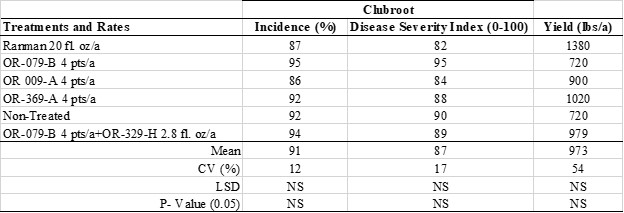Objective: To determine the effect of non-traditional products alone and in combination to manage clubroot on canola.
Methods: The following non-traditional products (OR-079-B, OR 009-A, OR-369-A and OR-329-H) were tested alone and in combination in a randomized complete block design (RCBD) with six replications under field conditions. The field had a natural soil population of P. brassicae of 5.5 million resting spores/g of soil. Treatments of non-traditional products and the fungicide Ranman®, were applied in-furrow as soil drenches just before planting at the rate listed in Figure 1. A susceptible canola cultivar to clubroot ‘InVigor L233P’ was planted at a depth of one half inch. The trial was planted the first week of June and was evaluated in the first week of August (exactly 60 days after planting) at growth stage BBCH-65. The trial was hand harvested the last week of August and the yield data was calculated in lbs/a at 13.5% moisture.
Rating scale: A clubroot rating scale: 0 = no galling, 1 = a few small galls (small galls on less than 1/3 of roots), 2 = moderate galling (small to medium-sized galls on 1/3 to 2/3 of roots), 3 = severe galling (medium to large-sized galls on more than 2/3 of roots) was used for disease rating of incidence and severity. A Clubroot Disease Severity Index (DSI) has been calculated using the incidence and severity data of clubroot obtained.
Soil sampling to determine pH: Soil samples were collected from all of the plots before application of soil treatments and on the day of clubroot evaluations to determine the effect of unit change in pH and their impact on clubroot control.
Figure 1: Means of the Clubroot DSI and their effect on the yield observed in various treatments of non-traditional products.

